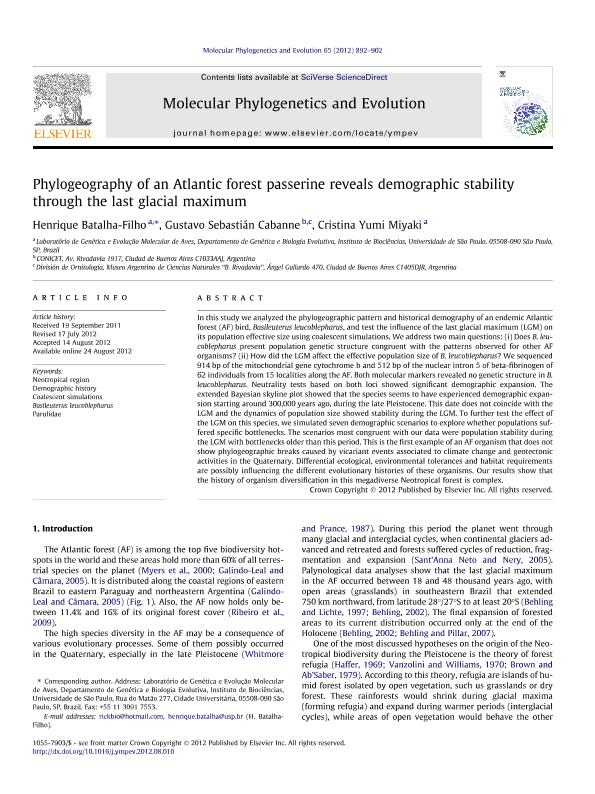Mostrar el registro sencillo del ítem
dc.contributor.author
Batalha-Filho, Henrique
dc.contributor.author
Cabanne, Gustavo Sebastián

dc.contributor.author
Miyaki, Cristina Yumi

dc.date.available
2020-02-18T18:16:27Z
dc.date.issued
2012-12
dc.identifier.citation
Batalha-Filho, Henrique; Cabanne, Gustavo Sebastián; Miyaki, Cristina Yumi; Phylogeography of an Atlantic forest passerine reveals demographic stability through the last glacial maximum; Academic Press Inc Elsevier Science; Molecular Phylogenetics and Evolution; 65; 3; 12-2012; 892-902
dc.identifier.issn
1055-7903
dc.identifier.uri
http://hdl.handle.net/11336/97927
dc.description.abstract
In this study we analyzed the phylogeographic pattern and historical demography of an endemic Atlantic forest (AF) bird, Basileuterus leucoblepharus, and test the influence of the last glacial maximum (LGM) on its population effective size using coalescent simulations. We address two main questions: (i) Does B. leucoblepharus present population genetic structure congruent with the patterns observed for other AF organisms? (ii) How did the LGM affect the effective population size of B. leucoblepharus? We sequenced 914. bp of the mitochondrial gene cytochrome b and 512. bp of the nuclear intron 5 of beta-fibrinogen of 62 individuals from 15 localities along the AF. Both molecular markers revealed no genetic structure in B. leucoblepharus. Neutrality tests based on both loci showed significant demographic expansion. The extended Bayesian skyline plot showed that the species seems to have experienced demographic expansion starting around 300,000. years ago, during the late Pleistocene. This date does not coincide with the LGM and the dynamics of population size showed stability during the LGM. To further test the effect of the LGM on this species, we simulated seven demographic scenarios to explore whether populations suffered specific bottlenecks. The scenarios most congruent with our data were population stability during the LGM with bottlenecks older than this period. This is the first example of an AF organism that does not show phylogeographic breaks caused by vicariant events associated to climate change and geotectonic activities in the Quaternary. Differential ecological, environmental tolerances and habitat requirements are possibly influencing the different evolutionary histories of these organisms. Our results show that the history of organism diversification in this megadiverse Neotropical forest is complex.
dc.format
application/pdf
dc.language.iso
eng
dc.publisher
Academic Press Inc Elsevier Science

dc.rights
info:eu-repo/semantics/openAccess
dc.rights.uri
https://creativecommons.org/licenses/by-nc-sa/2.5/ar/
dc.subject
BASILEUTERUS LEUCOBLEPHARUS
dc.subject
COALESCENT SIMULATIONS
dc.subject
DEMOGRAPHIC HISTORY
dc.subject
NEOTROPICAL REGION
dc.subject
PARULIDAE
dc.subject.classification
Genética y Herencia

dc.subject.classification
Ciencias Biológicas

dc.subject.classification
CIENCIAS NATURALES Y EXACTAS

dc.title
Phylogeography of an Atlantic forest passerine reveals demographic stability through the last glacial maximum
dc.type
info:eu-repo/semantics/article
dc.type
info:ar-repo/semantics/artículo
dc.type
info:eu-repo/semantics/publishedVersion
dc.date.updated
2020-02-07T13:37:25Z
dc.journal.volume
65
dc.journal.number
3
dc.journal.pagination
892-902
dc.journal.pais
Estados Unidos

dc.journal.ciudad
Amsterdam
dc.description.fil
Fil: Batalha-Filho, Henrique. Universidade de Sao Paulo; Brasil
dc.description.fil
Fil: Cabanne, Gustavo Sebastián. Consejo Nacional de Investigaciones Científicas y Técnicas. Oficina de Coordinación Administrativa Parque Centenario. Museo Argentino de Ciencias Naturales “Bernardino Rivadavia”; Argentina
dc.description.fil
Fil: Miyaki, Cristina Yumi. Universidade de Sao Paulo; Brasil
dc.journal.title
Molecular Phylogenetics and Evolution

dc.relation.alternativeid
info:eu-repo/semantics/altIdentifier/url/https://www.sciencedirect.com/science/article/pii/S1055790312003193
dc.relation.alternativeid
info:eu-repo/semantics/altIdentifier/doi/http://dx.doi.org/10.1016/j.ympev.2012.08.010
Archivos asociados
